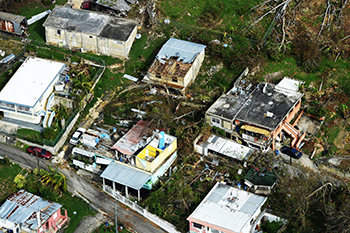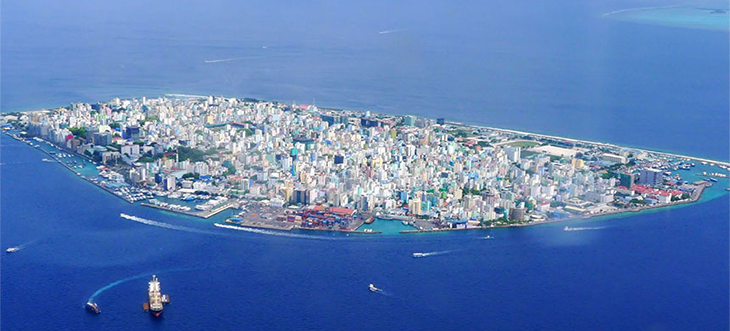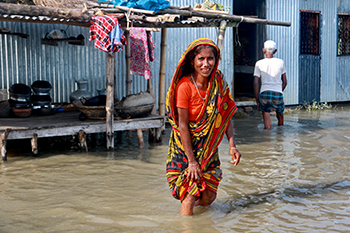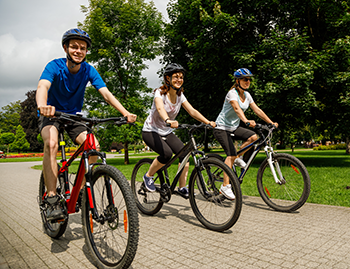Climate change sets people on the move
Many people are adapting to uncomfortable changes in their homelands by migrating elsewhere

Many people evacuated the island of St. Maarten before Hurricane Irma struck last year. It was one of several hurricanes that year believed to have been made worse by climate change.
Staff Sgt. Angel Oquendo/U.S. Air National Guard
Share this:
- Share via email (Opens in new window) Email
- Click to share on Facebook (Opens in new window) Facebook
- Click to share on X (Opens in new window) X
- Click to share on Pinterest (Opens in new window) Pinterest
- Click to share on Reddit (Opens in new window) Reddit
- Share to Google Classroom (Opens in new window) Google Classroom
- Click to print (Opens in new window) Print
This is the first in a 10-part series about the ongoing global impacts of climate change. These stories will look at the current effects of a changing planet, what the emerging science suggests is behind those changes and what we all can do to adapt to them.
On September 21, 2017, the day after Hurricane Maria swept across Puerto Rico, Yolimar Garayalde Figueroa stepped outside her home. At once, she saw that everything had changed.
“It felt like we were back in my grandparents’ time,” she recalls. “Everything was destroyed…. There was absolutely no phone reception, no TV, no wifi. If you wanted to know about a person, you had to go directly to them.”
During the storm, a tree fell on the family home, cracking the ceiling above Figueroa’s bed. The rain and wind, which peaked at 250 kilometers (155 miles) per hour, blew in the home’s windows. Water flooded the structure, destroying many of the family’s possessions.

Soon Figueroa would discover the storm had destroyed much of the rest of her island as well. That included its power grid, meaning no one had electricity. For many — including Figueroa and her family — water no longer flowed from the kitchen tap. “We went eight months without electricity and six without water,” she notes.
Before the storm, Figueroa attended the University of Puerto Rico. But she soon found it impractical to return that fall. The hurricane had destroyed one of the family’s two cars. Now they all had to share just one. With no power or wifi, studying would be impossible. Plus, she adds, “I knew I had to work even more hours than I already did to help my family get back on track.”
Then an opportunity arose. The University of Central Florida offered the teen a spot at its campus in Orlando. Figueroa’s parents encouraged her to go for it. “They told me I needed to stay focused on my studies.” So Figueroa packed her bags, got on a plane and joined thousands of storm-ravaged Puerto Ricans who left this U.S. territory for the mainland.
Many people move away from home when they grow up. They may leave for a better education, better job opportunities or because they’ve just always wanted to live somewhere else. But they also may leave because some event made their home a dangerous or unwelcome place to live or work. Natural disasters, for instance, prompt some 26.4 million people globally to leave their homes, on average, each year.
“Migration has always been a strategy and has always been a part of human life,” notes Julia Blocher. She studies the links between climate change and migration at the Potsdam Institute for Climate Impacts Research in Germany.
Hurricane Maria is just one of the many recent natural events believed to have been made worse by climate change. Scientists now point to events around the globe — heat waves, droughts, floods, powerful storms and more — as evidence that climate change is no longer a figment of the future. It is happening now. And it can affect someone’s decision to leave or stay, even if they don’t realize it.
Some, such as Figueroa, move within their home country. Others cross borders to foreign lands. Some eventually return home. Others will never be able to return. So far, the numbers aren’t huge. But in the not-too-distant future, millions could find themselves migrating long distances in response to Earth’s changing climate.
It’s getting hot in here
Around 1850, the Industrial Revolution got underway. People started using fossil fuels — coal, oil and natural gas — in large amounts. Burning these fuels, along with other human activities, released carbon dioxide and other greenhouse gases. Many of these gases could already be found in the atmosphere. They help to keep heat close to the planet’s surface. But as people began spewing a big excess of the gases, this thermal “blanket” thickened. It now holds more and more heat near Earth’s surface.
As a result, the average temperature today is a full 1 degree Celsius (1.8 degrees Fahrenheit) higher than it was in 1850.
That may not sound like a lot of heat. After all, a 15 °C (59 °F) day isn’t that much different from one that is 14 °C (57.2 °F). But planet-wide, this small rise in temperature has had big effects.
That extra energy has prompted weather patterns to change. Some forms of dramatic weather, such as droughts and floods, have become more common or extreme. From 2011 to 2014, for instance, California experienced its driest-known period — a drought that didn’t end till just last year. Meanwhile, Washington, D.C., has been enduring one of its wettest years ever recorded. And some hurricanes, such as last year’s Harvey, have been made worse by climate change.
NASA Climate Change/YouTube
Temperatures have risen faster in the Arctic, where sea ice is dwindling. Scientists say the summer sea ice may be totally gone by as early as 2030. At the other end of the planet, Antarctica has lost nearly 3 trillion metric tons of ice since just 1992. That has contributed to sea level rise, along with melting Greenland ice and warmer, less dense water. Coastal flooding, especially at high tides, has now become commonplace in many locations.
Warmer temperatures also mean that spring now comes earlier. And to escape uncomfortable temperatures, many animals and plants have been migrating too — toward the poles.
J. Marshall Shepherd is meteorologist at the University of Georgia in Athens. At a briefing this past August, he likened climate change to baking cookies. “Depending on how much sugar, flour or chocolate chips you place in your recipe, you are going to get a slightly different cookie. But it is still going to come out [of the oven] looking like a cookie.” Changing the recipe for climate — by adding more greenhouse gases to the atmosphere — produces weather that is similar to what you expect. But, he adds, it’s not quite the same. “We get this sort of different cookie.”
In many parts of the world, changes to the planet have been subtle enough for people to easily ignore, especially if they live in wealthier countries. It still snows in winter, although maybe not as much as it did decades ago. It still gets hot in summer, though heat waves tend to now be hotter. And for those changes that can’t be ignored, some people can fairly easily adapt, such as by buying an air conditioner.
For many others, however, adapting is becoming ever harder. Farmers, for instance, may have to deal with more frequent or longer droughts. People who live near the shore may find high tides and storms flooding their homes more often. And air conditioners can’t help people who have to work outdoors — or those that can’t afford them. Climate change can also cause communities to lose some of their resilience. This is their ability to recover from extreme events.
“The people who are most affected by climate change are from the poorest communities in the poorest countries,” says Blocher. But climate change hasn’t left any part of the globe untouched. “Rich countries are also affected.”
Migrants take off around the globe
In August 2016, residents of Shishmaref, Alaska, voted to abandon the island on which their village sat. The loss of Arctic sea ice had left the island vulnerable to coastal erosion. Houses had already been lost to storms and sea. More would surely follow.
Other towns in Alaska are similarly vulnerable and also may soon decide to pick up and leave.
In Louisiana, the U.S. government has agreed to resettle the people of Isle de Jean Charles. Their island has mostly sunk into the Gulf of Mexico.
In the remote Pacific, the island nation of Kiribati bought land in Fiji in 2014 so that its residents will have a place to go when their low-lying nation floods to the point of becoming uninhabitable.

Sea level rise and related erosion could leave tens of millions of people or more homeless in the coming decades. These are people who will have to find somewhere else to live. But for many, deciding whether to migrate and where to go will not be simple. “Who actually moves,” says Valerie Mueller, “can depend on the disaster and the location.”
Mueller is an economist at Arizona State University in Tempe. Among the things that she studies is how rural people in Africa and Asia respond to changes in climate. In the past, she says, scientists made assumptions about who would move away when their environment changed. Those assumptions are now thought to be exaggerated. People often don’t move even when it might be expected.
“People don’t want to leave their families,” she explains. Also, in many parts of the world, land only belongs to people as long as they occupy it. If they leave, they can lose that land forever.
And there may be other barriers to moving. Potential migrants may not speak the language of the place they would move to — even if it’s in the same country. They may have no one to help them when they move into that new place. Or they may not have enough money to move.
A person’s situation matters. For instance, even with no power or electricity at home in Puerto Rico, Figueroa says that her parents never considered leaving. Her grandparents live with them, she notes, “and under no circumstances [do] they want to abandon their home.”
Blocher cites recent research suggesting “that the poorest and the richest people tend not to move in the case of climate crises or slow-onset events.” The poorest “simply lack the resources [such as money] to move,” she says. Rich folk, in contrast, “don’t have to move because they are in a better position and more able to bear the shock.”
The type of disaster also can affect someone’s decision to move.

Mueller has conducted studies in Bangladesh. During the monsoon season, flooding is common in this low-lying, South Asian country. She and her colleagues looked at when people chose to move from their homes. Heat and temperature, they found, were bigger predictors of migration than was flooding.
“People are accustomed to dealing with floods,” she notes. So these people know what to do when the water comes. “They’ll go to higher ground, or they’ll go live with their extended family,” she says. And because floods are common, programs exist to help many of the affected. So when they come back, they’ll use those programs to rebuild. They also know that the floods will have enriched their farmland.
But there aren’t such formal (or informal) ways of dealing with more infrequent events, such as droughts. “So in that context,” Mueller says, “people tend to move.”
When it comes to droughts and other such slow-onset events, detecting whether climate change prompted someone to migrate can prove difficult. People can move at different times and seemingly for different reasons, Blocher notes. “Climate change and environmental degradation is typically not the only — or even the most important — reason for movement.” People may report wanting to improve their income or to avoid being discriminated against in some way within their home town or country.
Several studies have estimated how many people might become climate migrants. One 2018 report by the World Bank, for instance, focused on sub-Saharan Africa, Southeast Asia and Latin America. Within the next 32 years, climate change could force some 143 million people in these places to pack up and find a new home within their own country, it concluded.
So far, Blocher says, there’s not a lot of evidence that climate change is increasing the numbers of migrants. However, research does show “that climate change and environmental degradation is likely to be altering migration trends and patterns — including time scales, distances and numbers of migrations.”
Leaving home isn’t always forever
Hurricane Maria arrived at a time when many people already were leaving Puerto Rico, notes Elizabeth Aranda. She is a sociologist at the University of South Florida in Tampa. The island had been suffering from money woes for nearly a decade. Many people were unable to find jobs. Poverty rates had climbed. So it’s perhaps not surprising, she says, that in recent years “Puerto Rico lost quite a lot of its population.”
(Aranda herself decided to leave Puerto Rico when she got old enough for college. It was “a really difficult decision,” she says. “I was always torn between wanting to achieve these academic goals but also really missing my family, really missing the place where I grew up.”)

The hurricane, however, prompted new waves of people to quickly head to the mainland, at least for a bit. And they have dealt with many of the same issues facing migrants around the world.
“It can take a toll,” Aranda says. “There’s a host of challenges that you deal with when you integrate into a new society.” There can be differences in language. Migrants will have to find new jobs and a place to live. If they were forced to leave their homes, they could be missing their homeland “and what it could have been,” Aranda says. “You can still communicate [with people back home] over phone and Skype and FaceTime. But it’s not the same.”
This can all be very, very painful — and sad. Puerto Rico, she says, is “mourning an island that’s been devastated by a hurricane.”
And not everyone will welcome the migrants, no matter why they came. Still, “migration can be a win, win, win situation,” Blocher argues. Migrants get access to jobs, resources, knowledge and skills in their new home. They contribute to those new homes in many ways, from paying taxes and starting businesses to sharing their food and culture. They often send some money back home. And if they eventually move back, they can bring their new skills and knowledge with them.
Figueroa, for instance, plans to return to Puerto Rico after college and law school. She would like to help people who end up in jail because they lack the money for a lawyer. “I know I can help my people,” she says. “And in the future, I’ll come back with the necessary tools to help as many as I can.”
Migration is one way that humanity can adapt to climate change. But adaptation is only one half of the climate change solution. The other is mitigation. This means reducing — and eventually eliminating — greenhouse gas emissions. Scientists describe this move to lower carbon-dioxide emissions as reducing our “carbon footprint.” It is likely to be the best way to stop temperatures from rising,
In 2015, nearly every nation around the globe agreed to limit those emissions. Their stated goal was to keep temperatures from rising more than 2 degrees C (3.6 degrees F) above pre-industrial times. (The United States later announced its intention to withdraw from the agreement.) Many nations have since announced measures to reduce their emissions. These may include phasing out the use of coal or banning the sale of gasoline- or diesel-powered cars.
But individuals can also do their part. They can run their air conditioners less. They can turn down the thermostat (and put on sweaters) at home in winter. They can ride bikes instead of using cars. They can use energy-efficient light bulbs, or change the source of their electricity to solar, wind or nuclear (which don’t produce greenhouse gases). Or they can take any number of other small actions to reduce their individual emissions.
“Our little carbon footprint,” Mueller notes, “makes a big difference.”






